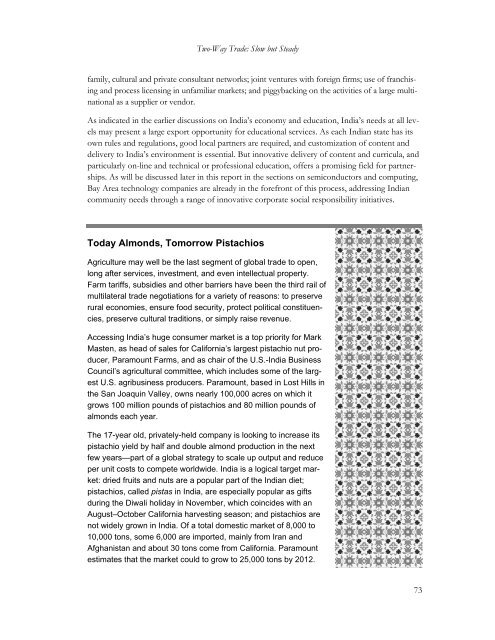PDF: 2962 pages, 5.2 MB - Bay Area Council Economic Institute
PDF: 2962 pages, 5.2 MB - Bay Area Council Economic Institute
PDF: 2962 pages, 5.2 MB - Bay Area Council Economic Institute
Create successful ePaper yourself
Turn your PDF publications into a flip-book with our unique Google optimized e-Paper software.
Two-Way Trade: Slow but Steady<br />
family, cultural and private consultant networks; joint ventures with foreign firms; use of franchising<br />
and process licensing in unfamiliar markets; and piggybacking on the activities of a large multinational<br />
as a supplier or vendor.<br />
As indicated in the earlier discussions on India’s economy and education, India’s needs at all levels<br />
may present a large export opportunity for educational services. As each Indian state has its<br />
own rules and regulations, good local partners are required, and customization of content and<br />
delivery to India’s environment is essential. But innovative delivery of content and curricula, and<br />
particularly on-line and technical or professional education, offers a promising field for partnerships.<br />
As will be discussed later in this report in the sections on semiconductors and computing,<br />
<strong>Bay</strong> <strong>Area</strong> technology companies are already in the forefront of this process, addressing Indian<br />
community needs through a range of innovative corporate social responsibility initiatives.<br />
Today Almonds, Tomorrow Pistachios<br />
Agriculture may well be the last segment of global trade to open,<br />
long after services, investment, and even intellectual property.<br />
Farm tariffs, subsidies and other barriers have been the third rail of<br />
multilateral trade negotiations for a variety of reasons: to preserve<br />
rural economies, ensure food security, protect political constituencies,<br />
preserve cultural traditions, or simply raise revenue.<br />
Accessing India’s huge consumer market is a top priority for Mark<br />
Masten, as head of sales for California’s largest pistachio nut producer,<br />
Paramount Farms, and as chair of the U.S.-India Business<br />
<strong>Council</strong>’s agricultural committee, which includes some of the largest<br />
U.S. agribusiness producers. Paramount, based in Lost Hills in<br />
the San Joaquin Valley, owns nearly 100,000 acres on which it<br />
grows 100 million pounds of pistachios and 80 million pounds of<br />
almonds each year.<br />
The 17-year old, privately-held company is looking to increase its<br />
pistachio yield by half and double almond production in the next<br />
few years—part of a global strategy to scale up output and reduce<br />
per unit costs to compete worldwide. India is a logical target market:<br />
dried fruits and nuts are a popular part of the Indian diet;<br />
pistachios, called pistas in India, are especially popular as gifts<br />
during the Diwali holiday in November, which coincides with an<br />
August–October California harvesting season; and pistachios are<br />
not widely grown in India. Of a total domestic market of 8,000 to<br />
10,000 tons, some 6,000 are imported, mainly from Iran and<br />
Afghanistan and about 30 tons come from California. Paramount<br />
estimates that the market could to grow to 25,000 tons by 2012.<br />
73








